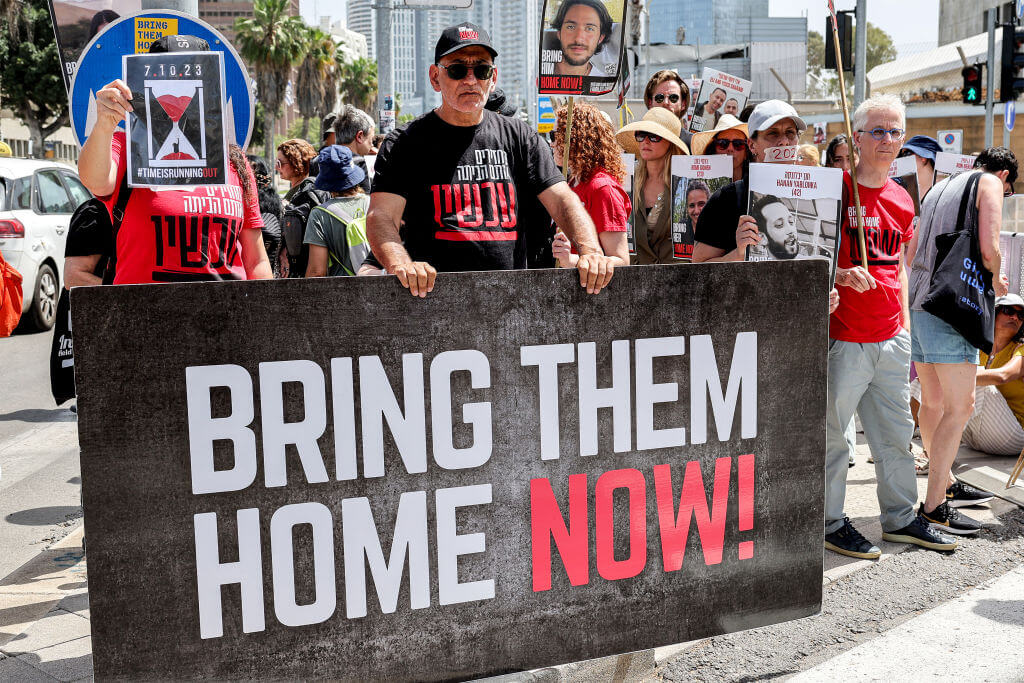Two more hostages, including an American Israeli, are seen in video released by Hamas
The proof of life video is released as pressure mounts on the terrorist group to accede to the terms of a ceasefire and hostage release

Friends and family of the Israeli hostages held in Gaza protest outside the Defense Ministry headquarters in Tel Aviv on April 25. Photo by Getty Images
(JTA) — Hamas released its second hostage proof of life video in a weeks, this time featuring Omri Miran and Keith Siegel, as pressure mounts on the terrorist group to accede to the terms of a ceasefire and hostage release.
Siegel, 64, is one of several American-Israeli hostages among the 130 or so still held by Hamas. The families of Siegel and Miran, 47, said Saturday through a group representing the families of hostages that they did not oppose media posting and describing the 3.5 minute video.
Both men appeal to Israel’s leaders to end the fighting. “There is at times a sense that things are a mess,” Siegel said. “I call on the prime minister and the whole government to participate in negotiations, to get to a deal soon.”
Miran says, “The time has come to come to an agreement that will get its out of here alive.”
The video comes just days after another appeal by Hersh Goldberg-Polin, another American Israeli being held hostage.
U.S. negotiators say the roadblock to a hostage release lies with Hamas, which has rejected a deal that would trade the hostages for Palestinians held prisoner in Israel and a ceasefire that would last at least six weeks, as well as the entry of humanitarian restrictions with fewer restrictions.
This week, the Biden administration spearheaded a statement from the 18 countries with citizens among the hostages calling on Hamas to accept the agreement. Israel said it was pleased by the statement.
Hamas wants a guarantee that Israeli troops will fully withdraw from the enclave. “We express our disappointment that the statement [by the 18 countries] failed top address fundamental issues affecting our people,” it said in a statement it posted Saturday on Telegram. “It notably omitted the urgent need for a lasting ceasefire and the complete withdrawal of the occupation troops from Gaza.”
Hamas launched the war on Oct. 7 when it massacred hundreds of people inside Israel and abducted more than 250. More than 130 hostages remain, although it is not known how many are alive. Tens of thousands of Palestinians have been killed since Israel launched counterstrikes, and hundreds of thousands of Palestinians have been displaced. International health officials say the enclave is on the verge of famine.
Israeli Prime Minister Benjamin Netanyahu says he is determined to go ahead with a planned major operation in Rafah, a city on the Gaza-Egypt border which is believed to be the last redoubt of Hamas’ armed forces, and which is also where hundreds of thousands of Palestinians in the strip have sought refuge.
Netanyahu has faced mass weekly protests, including on Saturday night, for not doing enough to come to a deal to free the hostages. Yehuda Cohen, the father of Nimrod Cohen, a soldier held hostage in Gaza, on Saturday told reporters that the families’ anger extends to other members of the Cabinet, who are reported to favor more flexibility to achieve a deal, but face resistance from Netanyahu.
“We tell Benny Gantz and Gadi Eizenkot, every hostage who entered Gaza alive and comes out dead, the blood is on your hands,” Cohen said at a press conference in Israel broadcast by the government-run Kan broadcaster. “Netanyahu sabotaged every deal again and again and you were silent.”
In the video, Hamas interpolates the statements by Siegel and Miran, delivered as they sit against a dark background, with footage of Prime Minister Benjamin Netanyahu and Defense Minister Yoav Gallant saying increased military pressure will release the hostages.
Hamas follows those statements with titles in Hebrew saying that has not been the case.
“Military pressure did not succeed in freeing your sons,” one title says. “It killed dozens of hostages held by us and kept dozens of others from celebrating Passover with their loved ones.”
The camera lingers on Siegel as he collapses into tears recalling how much he enjoyed Passover with his family last year. Siegel grew up in Durham, North Carolina.
The video ends with the warning, “Do what is needed before it is too late.”
Siegel’s family released their own video after Hamas released the proof of life. His daughters, Ilan and Shir, urged people to turn out at the protests, which Keith Siegel said he has seen while in captivity.
“Seeing my father today only emphasizes to all of us how much we must reach a deal as soon as possible and bring everyone home,” Ilan said. “I demand that the leaders of this country watch this video and see their father crying out for help.”
His wife, Aviva, who was abducted and released in an exchange 51 days later, concludes the video: “Keith, I love you, we will fight until you return.”
This article originally appeared on JTA.org.
A message from our CEO & publisher Rachel Fishman Feddersen
I hope you appreciated this article. Before you go, I’d like to ask you to please support the Forward’s award-winning, nonprofit journalism during this critical time.
We’ve set a goal to raise $260,000 by December 31. That’s an ambitious goal, but one that will give us the resources we need to invest in the high quality news, opinion, analysis and cultural coverage that isn’t available anywhere else.
If you feel inspired to make an impact, now is the time to give something back. Join us as a member at your most generous level.
— Rachel Fishman Feddersen, Publisher and CEO